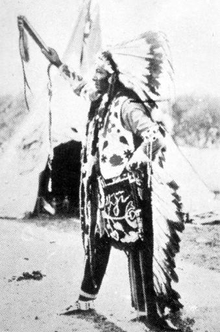- White Bird (Native American leader)
-
White Bird 
Tribe Lamátta Died March 6, 1892
Pincher CreekNative name Peo-peo-hix-hiix Cause of death Murder White Bird (Peo-peo-hix-hiix), also referred to as White Pelican (died 1892), was a leader and war chief of the Lamátta band of the Nez Perce tribe.[1]
Contents
History
Chief White Bird, like many of his people, was a Dreamer, a follower of the teachings of Smohalla, the Wanapam shaman and prophet. Alongside Chief Joseph, White Bird directed the 1877 withdrawal from eastern Oregon into Montana and ahead toward the Canadian border during the Nez Perce War. White Bird and Joseph led the Nez Percé Indians until October 1877, when General Nelson Miles of the U.S. Army attacked them at Snake Creek at the Battle of Bear Paw, south of Havre, Montana. Following a five-day fight, Joseph and many of the fatigued band acknowledged a cessation of hostilities, surrendered to Miles, and became prisoners of war.
White Bird refused to relinquish, and left on the night of October 5. He effectively slipped through enemy lines with over a hundred of the band.
Canada
In October 1877, about ninety adults and a great number of children led by White Bird arrived with some three hundred head of horses at Sitting Bull's camp in Saskatchewan. White Bird and his family settled in Pincher Creek, Alberta, area to live out their lives. The war chief never returned to the United States, choosing to stay in Canada at Pincher Creek. White Bird was murdered on March 6, 1892, by a fellow Nez Percé named Charley Hasenahamahkikt.[2]
Other facts
The town of White Bird, Idaho, and the adjacent White Bird Hill in Idaho County are named for the chief. The Battle of White Bird Canyon took place in this area in June 1877.
See also
- Sitting Bull
- Chief Joseph
- Nez Percé
- White Bird, Idaho
References
- ^ "Chief Joseph Biography". Oregon Historical Society. http://www.ohs.org/the-oregon-history-project/biographies/Chief-Joseph.cfm. Retrieved August 12, 2011.
- ^ "White Bird", US Forest Service, Nez Perce National Historic Trail website. Retrieved on 2008-08-12.
- http://www.u-s-history.com/pages/h3858.html
- http://www.fs.fed.us/npnht/people/whitebird.shtml
- http://www.nps.gov/nepe/planyourvisit/upload/WHBI_Guide_WEB.pdf

This article about an Indigenous person of North America is a stub. You can help Wikipedia by expanding it.
